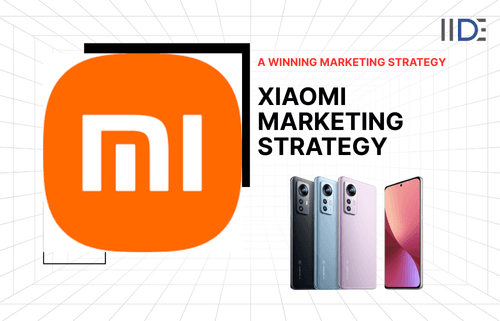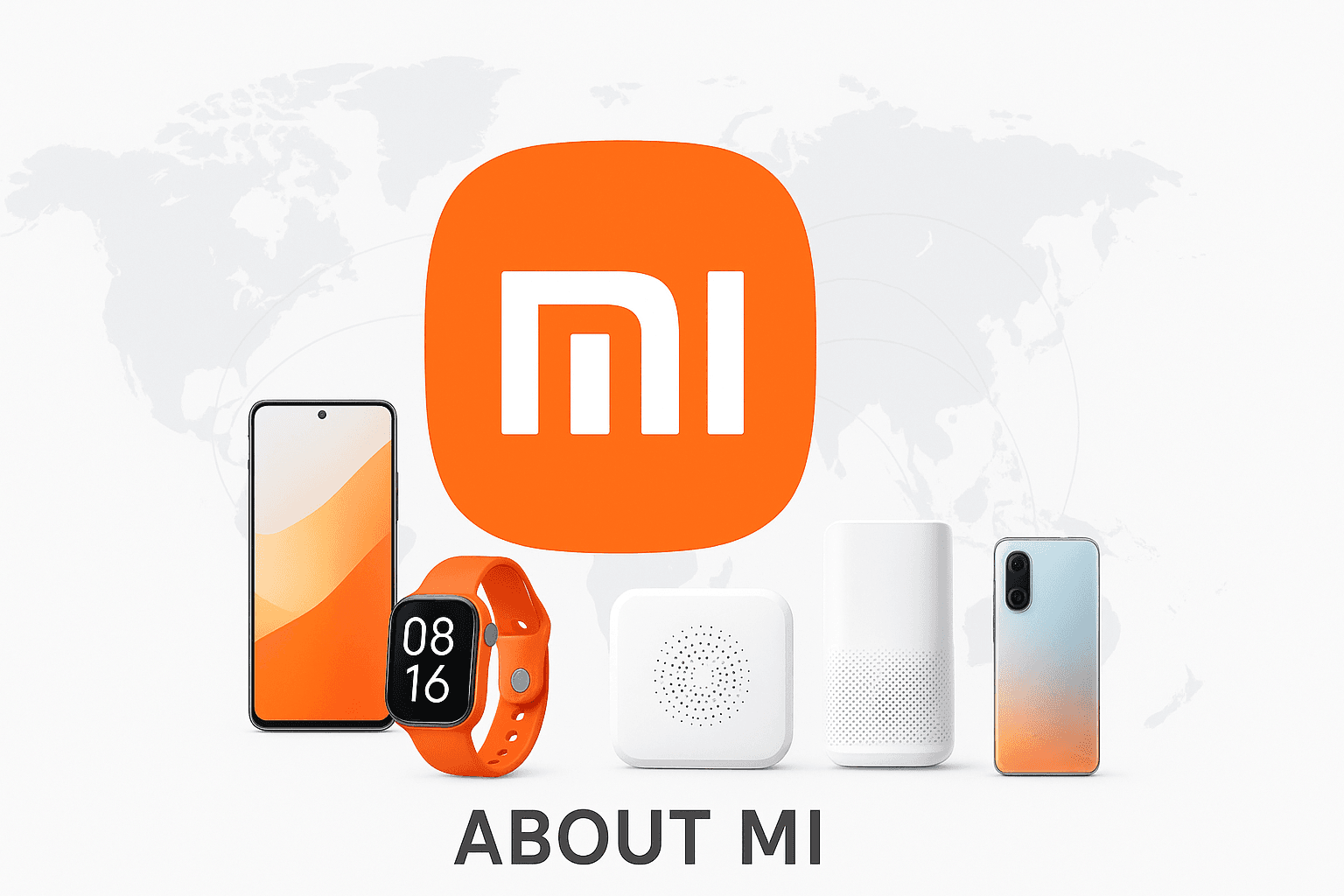Decode how AI is reshaping careers in 2026 with our Head of AI Programs in a LIVE online session. Register Now.

Updated on Nov 17, 2025
Share on:
Xiaomi's marketing strategy centers on providing high-quality products at affordable prices, utilizing online sales, fostering a devoted fan base through social media and word-of-mouth, creating demand with limited-quantity flash sales, building an AIoT ecosystem to promote brand loyalty, and adapting localization for different markets, particularly in India.
Before diving into the article, I’d like to inform you that the research and initial analysis for this piece were conducted by Soham Chavan. He is a current student of IIDE's PG Program (December 2024 Batch).
If you find this case study helpful, feel free to reach out to Soham to send a quick note of appreciation for his fantastic research - he’ll appreciate the kudos!
About Xiaomi
Founded in 2010 by Lei Jun, Xiaomi is a leading global consumer electronics and smart technology brand.
The company began with smartphones, disrupting the market by offering high-quality features at affordable prices.
This strategy helped them become a top global competitor to brands like Apple and Samsung.
In India, Xiaomi transformed the smartphone market, offering premium features at budget-friendly prices.


Learn Digital Marketing for FREE


Marketing Objective or Business Challenge
To leverage its AIoT ecosystem and devoted fan base to increase brand loyalty and market share in premium and new product categories, like electric products, with a focus on delivering high-quality, innovative technology at honest prices.
Navigating intense competition in key markets like India, where regulatory challenges and a decrease in marketing investment have led to declining sales and a negative market perception, while also needing to build a stronger brand reputation in the premium segment globally.
Buyers Persona:

Tech-Savvy Value Seeker
Metropolitian City
Occupation: Marketing Head
Age: 24 years
Motivation
- Wants premium technology at affordable prices
- Seeks innovation, performance, and reliability without overspending
- Motivated by social status (owning the latest tech), but also values cost-effectiveness
- Prefers a brand ecosystem (smartphone + wearables + smart home)
Interest & Hobbies
- Loves mobile gaming, photography, and streaming content
- Interested in gadgets, tech reviews, and new launches
- Engages in online communities, especially around technology and lifestyle
- Fitness-conscious (smartwatches, wearables)
Pain Points
- Frustrated with expensive flagship brands (Apple/Samsung)
- Needs long-lasting battery, performance, and affordability
- Wants quick availability (no stock delays during launches)
- Concerned about after-sales service and durability
Social Media Presence
- Highly active on Instagram, YouTube, and Twitter (X) → follows tech influencers & reviewers
- Uses Facebook & WhatsApp for community groups and deals
- Frequently shops on Amazon, Flipkart, and Mi.com
- Engages with Reddit & forums for honest reviews before purchase
Marketing Channels Used by Xiaomi in 2025
Xiaomi followed a win-win marketing strategy that blended performance marketing, SEO, influencer campaigns, and an omni-channel retail presence.
On the digital front, they invested in:
- To increase organic reach, Xiaomi relies on SEO and a strong content marketing strategy
- They use Google Ads across Search, Display, and Performance Max to target tech-savvy consumers
- Xiaomi also uses YouTube Shorts and Instagram Reels to create quick, engaging videos that highlight product features
- To build trust and authority, Xiaomi partners with top tech reviewers, YouTubers, and lifestyle influencers
They also gained traditional media exposure through features in the Hindustan times, Financial Express, and other reputed publications.
When it comes to sales, Xiaomi kept its focus on direct-to-consumer (D2C) through its website while also listing on marketplaces like Amazon and maintaining an offline presence also.
This multi-channel Marketing Strategy of Xiaomi helped it spread awareness, educate its audience, and turn traffic into loyal customers.
Marketing Strategy Breakdown for 2025
1. Content Marketing & SEO
Xiaomi's marketing strategy placed a strong focus on SEO-driven content to grow its organic traffic and to attract tech-savvy and young people.
They published blog articles, such as “Xiaomi and EUN: empowering digital access,” targeting both informational and transactional keywords.
Some of the keywords they ranked for included:
- Xiaomi digital access
- Tech accessibility for all
- Digital empowerment Xiaomi
On the technical side, they have good core web vitals on Desktop, but on mobile they have fix issues of being seamless. Within a few months, Xiaomi’s domain authority rose to 90 (very good), and they reached over 470.5k monthly organic visits.
2. Influencer Marketing
The "Gold Bar" Prank (India) Aimed to turn ordinary people into content creators and influencers, as they were the stars of the viral video. These creators shared:
- Honest reviews
- Unboxing videos
- Personal testimonials
What made this campaign work? It felt real. These influencers weren’t just promoting - they were explaining how Xiaomi’s phones made tech savvy easier. This made a hands-on experience, especially in Tier 1 and Tier 2 cities, where word-of-mouth still plays a big role in purchase decisions.
3. Google Ads & Performance Marketing
To reach high-intent audiences, Xiaomi’s full funnel approach
- Google Search & Display Ads
- Performance Max Campaigns
- YouTube Shorts showcases their unique tech
What's really cool is that their data-backed approach allowed real-time changes to copy, visuals, and targeting, making their campaigns efficient and impactful.
4. Messaging & Brand Voice
Xiaomi’s marketing strategy, especially the messaging part, revolves around loyalty and innovation. Focusing more towards affordability.
Their Slogan, “Smarter Living,” captures what the product is trying to convey through products.
Everything they communicate reflects four key themes:
- Convenience
- Durability
- Sustainability
- Innovation
Liking Xiaomi’s strategy? Check out this Apple marketing mix to see how the global tech leader leverages digital marketing to stay ahead.
Results & Impact
Xiaomi’s Marketing strategy worked and here are some Key highlights, results & impact:
- Xiaomi remains a top 3 global smartphone brand with a strong 14.7% market share.
- The company's brand recognition is growing quickly, as it climbed to #297 on the Fortune Global 500 list and was ranked #2 in a major Chinese global brand study
- The company is rapidly expanding its physical store presence, adding more than 1,700 new stores in a single quarter
- This growth is backed by a record-high investment in research and development to push new AI and technology
- Their overall platform now has over 731 million monhtly active users globally, and they've connected nearly 1 billion IoT devices to their platform
- The Mi Home App, which controls these devices, also saw a huge jump in users
What Worked & Why
The success behind Xiaomi’s marketing strategy is due to solving a real problem: young people tend to switch towards trends.
The innovative product caught people’s attention because it offered a practical solution for tech savvy.
Influencer marketing was effective because young people tend to trust other influencers. Xiaomi used micro-influencers to share authentic, relatable experiences.
All of this helped Xiaomi build trust and establish itself as a reliable, innovative brand.
What Didn’t Work & Why
Indian authorities have frozen over $560 million of Xiaomi's funds due to ongoing investigations. As a result of the scrutiny, Xiaomi has been forced to scale back its investments in India. This financial instability has caused significant investor wariness.
Regulatory and market pressures have led to a major change in Xiaomi's leadership team in India. This signals a difficult period for the company's local operations.
IIDE Student Recommendations: Key Areas for Brand Improvement
1.SEO Optimization
Xiaomi's marketing strategy should optimize its SEO focus by:
- On-page and content of that page by targeting commercial keywords, building authority driven blogs and creating a hub content
- Xiaomi's off-page SEO leverages its brand power and community so they can start generating community content, press and public relations
- Xiaomi's technical SEO is crucial for managing its massive, global e-commerce platform
2. Influencer Strategy
Nowadays, influencer play a huge role in creating an impact on the audience to shift them towards trust, urge to buy and worthiness.
- They should partner with top global tech reviewers like Marques Brownlee (MKBHD) to build credibility and get in-depth product reviews for their high-end phones
- In the Indian market, they collaborate with some of the most popular tech YouTubers and reviewers, including Technical Guruji (Gaurav Chaudhary), Tech Burner (Shlok Srivastava), and Trakin Tech (Arun Prabhudesai)
- Also, they can collab with celebrity Brand ambassadors
3. Strategic Media Plan
- Xiaomi should continue using Google Shopping Ads to showcase products directly in search results. For a complete approach, Performance Max campaigns are essential
- For users who have visited their website or watched a product video, Xiaomi should run targeted ads with specific product promotions. This is a highly effective way to convert warm leads into sales
- They can target the sale period on Amazon and Flipkart to run ads where conversion is more likely to be high
4. Smarter Email Marketing
Email automation can be personalized based on the past purchases, and browsing behavior. Campaigns like 'Diwali with Xiaomi' or festive collection previews can effectively nurture leads.
Want to Know Why 2,50,000+ Students Trust Us?
Dive into the numbers that make us the #1 choice for career success

MBA - Level
Post Graduate in Digital Marketing & Strategy
Best For
Fresh Graduates
Mode of Learning
On Campus (Mumbai & Delhi)
Starts from
Jan 5, 2026
Duration
11 Months
Live & Online
Advanced Online Digital Marketing Course
Best For
Working Professionals
Mode of Learning
Online
Starts from
Dec 19, 2025
Duration
4-6 Months

Online
Professional Certification in AI Strategy
Best For
AI Enthusiasts
Mode of Learning
Online
Duration
5 Months

Offline
Undergraduate Program in Digital Business & Entrepreneurship
Best For
12th Passouts
Mode of Learning
On Campus (Mumbai)
Duration
3 Years
Recent Post
Aditya Shastri leads the Business Development segment at IIDE and is a seasoned Content Marketing expert. With over a decade of experience, Aditya has trained more than 20,000 students and professionals in digital marketing, collaborating with prestigious institutions and corporations such as Jet Airways, Godrej Professionals, Pfizer, Mahindra Group, Publicis Worldwide, and many others. His ability to simplify complex marketing concepts, combined with his engaging teaching style, has earned him widespread admiration from students and professionals alike.
Aditya has spearheaded IIDE’s B2B growth, forging partnerships with over 40 higher education institutions across India to upskill students in digital marketing and business skills. As a visiting faculty member at top institutions like IIT Bhilai, Mithibai College, Amity University, and SRCC, he continues to influence the next generation of marketers.
Apart from his marketing expertise, Aditya is also a spiritual speaker, often traveling internationally to share insights on spirituality. His unique blend of digital marketing proficiency and spiritual wisdom makes him a highly respected figure in both fields.
